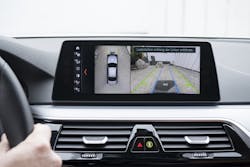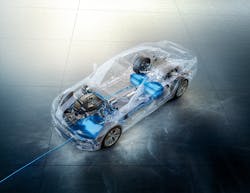BMW I has launched a world first in the form of a factory-fitted, fully integrated inductive charging facility for the high-voltage battery in a plug-in hybrid vehicle. Production was scheduled to start this month. As part of the BMW Group’s NUMBER ONE > NEXT strategy, the company is enhancing the ease of use and everyday practicality of electrified vehicles.
The product offer starts with Germany, subsequently followed by the UK, the U.S., Japan, and China. The BMW Wireless Charging option can be ordered now as a leasing-option for the BMW 530e iPerformance (fuel consumption in legislative EU test-cycle combined: 2.3 – 1.9 l/100 km; electricity consumption combined: 13.9 – 13.3 kWh/100 km; CO2 emissions combined: 52 – 47 g/km).
BMW Wireless Charging enables electric energy from the mains supply to be transmitted to a vehicle’s high-voltage battery without any cables—when the vehicle is positioned over a base pad. This can be installed in the garage, for example, and the charging process started as soon as the vehicle has been parked in position (without any further input from the driver). The launch of this technology sees the BMW Group move another step closer to an infrastructure that will make charging the battery of an electrified vehicle even simpler than refueling a car with a conventional engine.
1. The car is ready to accept GroundPad, which recharges the battery.
Available to customers as an option, BMW Wireless Charging consists of an Inductive Charging Station (GroundPad), which can be installed either in a garage or outdoors, and a secondary vehicle component (CarPad) fixed to the underside of the vehicle. The contactless transfer of energy between the GroundPad and CarPad is conducted over a distance of around eight centimeters. The GroundPad generates a magnetic field that is induced in the CarPad, which then charges the high-voltage battery. Figure 1 shows the GroundPad ready to accept the CardPad.
The system has a charging power of 3.2 kW, enabling the high-voltage batteries on board the BMW 530e iPerformance to be fully charged in about 3.5 hours. And with an efficiency rate of around 85%, charging with the BMW Wireless Charging system is very efficient.
BMW Wireless Charging employs the same inductive charging technology already widely used for supplying power to devices such as mobile phones and electric toothbrushes to recharge the high-voltage batteries in electrified vehicles. The principal benefit here is the ease of use, because drivers no longer need to hook up their plug-in hybrid car using a cable in order to replenish its energy reserves.
Instead, as soon as the vehicle has been parked in the correct position above the inductive Charging Station, followed by a simple push of the Start/Stop button, the charging process is initiated. Once the battery is fully charged, the system switches off automatically.
BMW Wireless Charging also helps the driver to maneuver into the correct parking position. A communication between the charging station and vehicle is being established via a Wi-Fi connection. An overhead view of the car and its surroundings (Fig. 2) then appears in the Control Display with colored lines that help guide the driver while parking. A graphic icon shows when the correct parking position for inductive charging has been reached. This can deviate from the optimum position by up to seven centimeters longitudinally and up to 14 centimeters laterally.
2. An overhead view of the car and its surroundings appears in the car’s Control Display to help guide the driver while parking to charge the battery.
The GroundPad can also be installed outdoors, where it may be used regardless of the weather conditions. All components that conduct electricity are protected from rain and snow, and driving over the GroundPad will not damage it in any way. During charging, ambient electromagnetic radiation is limited to the vehicle undercarriage. The GroundPad is permanently monitored and will be switched off if any foreign matters are detected. The BMW Group also offers an installation service for BMW Wireless Charging, on request.
3. The car’s Control Display includes a switch to initiate the recharging operation.
The launch of BMW Wireless Charging is proof of the BMW Group’s ongoing commitment to creating a user-friendly and practical charging infrastructure. In its role as one of the co-founders of the IONITY joint venture, the BMW Group is currently teaming up with other carmakers to set up a Europe-wide fast-charging network with up to 350 kW charging power for electric vehicles that should boast around 400 stations by 2020. In addition, the ChargeNow service, originally launched by BMW i, now offers access to more than 130,000 aggregated charging points in 32 countries. It is the largest global network of its kind.
BMW i is a BMW Group brand focusing on connected mobility services, visionary vehicle concepts, and a new understanding of premium strongly defined by sustainability. It is represented in 74 countries via the BMW i3 electric car for urban areas, BMW i8 plug-in hybrid sports car, and plug-in hybrid BMW iPerformance automobiles.
BMW i opens up new target groups for the company and serves as an incubator for innovations. Technologies which have debuted successfully in BMW i cars are carried over to parent brand BMW’s other models.
BMW i is also associated with enterprises including DriveNow (car sharing), ReachNow (car sharing 2.0), ChargeNow (easy access to the world’s largest network of charging points), ParkNow (straightforward location, reservation and payment of parking spaces), venture capital company BMW i Ventures (investment in start-up companies with a focus on urban mobility), BMW Energy (energy services) and the Centre of Competence for Urban Mobility (consultancy for cities).
About the Author

Sam Davis
Sam Davis was the editor-in-chief of Power Electronics Technology magazine and website that is now part of Electronic Design. He has 18 years experience in electronic engineering design and management, six years in public relations and 25 years as a trade press editor. He holds a BSEE from Case-Western Reserve University, and did graduate work at the same school and UCLA. Sam was the editor for PCIM, the predecessor to Power Electronics Technology, from 1984 to 2004. His engineering experience includes circuit and system design for Litton Systems, Bunker-Ramo, Rocketdyne, and Clevite Corporation.. Design tasks included analog circuits, display systems, power supplies, underwater ordnance systems, and test systems. He also served as a program manager for a Litton Systems Navy program.
Sam is the author of Computer Data Displays, a book published by Prentice-Hall in the U.S. and Japan in 1969. He is also a recipient of the Jesse Neal Award for trade press editorial excellence, and has one patent for naval ship construction that simplifies electronic system integration.
You can also check out his Power Electronics blog.




